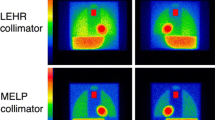Abstract
Heart to mediastinum count ratio (H/M) has been commonly utilized as an indicator of myocardial I-123 MIBG uptake. However, normal ranges of H/M were markedly different among various gamma camera systems. The purpose of this study was to clarify whether scatter correction by two-window method standardizes H/M among various gamma camera systems.Methods: Scatter uncorrected and corrected MIBG imaging was acquired in phantom and human studies in combination with low energy high-resolution collimator (LEHR) and medium energy collimator (MEC). For scatter correction, energy window width of 159 keV±10% was applied to main window imaging and 193 keV±9.5% was applied to upper window imaging for scatter correction.Results: In phantom study, a significant difference was observed in uncorrected H/M among three gamma camera systems using LEHR or MEC (2.09±0.06 vs. 2.58±0.03 in GCA 7200 camera, 2.00±0.07 vs. 2.42±0.06 in DS7 camera and 2.16±0.04 vs. 2.67±0.07 in Vertex plus camera). However, there was no significant difference in corrected H/M among the three gamma camera systems, either with LEHR or MEC (2.70±0.07 vs. 2.69±0.07 in GCA 7200 camera, 2.66±0.05 in DS7 camera and 2.66±0.05 vs. 2.61±0.05 in Vertex plus camera). In human study, uncorrected H/M in DS7 camera with LEHC was significantly lower than that in GCA 7200 camera with MEC (1.60±0.37 vs. 1.85±0.54, N=14). In contrast, the difference was insignificant in corrected H/M (2.12±0.59 vs. 2.16±0.68). There was a very excellent correlation in corrected H/M between DS7 and GCA 7200 cameras (r=0.991, p<0.001).Conclusion: This study demonstrated that scatter correction by the two-window method standardizes the H/M in MIBG scintigraphy either with LEHR or MEC. Scatter corrected H/M can be applied to measure a standardized parameter of MIBG uptake in human clinical studies using various gamma camera systems.
Similar content being viewed by others
References
Merlet P, Valette H, Dubois RJ, et al. Prognostic value of cardiac metaiodobenzylguanidine imaging in patients with heart failure.J Nucl Med 1992; 33: 471–477.
Nakata T, Miyamoto K, Doi A, et al. Cardiac death prediction and impaired cardiac sympathetic innervation assessed by MIBG in patients with failing and nonfailing heartsJ Nucl Cardiol 1998; 5: 579–590.
Momose M, Kobayashi H, Iguchi N, et al. Comparison of parameters of123I-MIBG scintigraphy for predicting prognosis in patients with dilated cardiomyopathy.Nucl Med Commun 1999; 20: 529–535.
Cohen-Solal A, Esanu Y, Logeart D, et al. Metaiodobenzylguanidine uptake in patients with moderate chronic heart failure: Relation with peak oxygen uptake and prognosis.J Am Coll Cardiol 1999; 33: 759–766.
Takeishi Y, Atsumi H, Fujiwara S, et al. ACE inhibition reduce cardiac iodine123I-MIBG release in heart failure.J Nucl Med 1997; 38: 1085–1089.
Nishimura T, Sugishita T, Sasaki Y. The results of questionnaire on quantitative assessment of123I-metaiodobenzylguanidine myocardial scintigraphy in heart failure.KAKU IGAKU (Jpn J Nucl Med) 1997; 34: 1139–1148.
Shiga K, Inoue T, Yamamoto K, et al. Difference in heart-to-mediastimun activity ratio of MIBG by the location of the ROI and the kind of collimator.Eizou Jyouhou 1996; 28: 1120–1123.
Motomura N, Ichihara T, Takayama T, Aoki S, Kubo H, Takeda K. Practical compensation method of downscattered component due to high energy photon in123I imaging.KAKU IGAKU (Jpn J Nucl Med) 1999; 36: 997–1005.
Baker GA, Lum DJ, Smith EM, et al. Significance of radiocontaminants in I123 for dosimetry and scintillation camera imaging.J Nucl Med 1976; 17: 740–743.
Macey DJ, DeNardo GL, DeNardo SL, et al. Comparison of Low-and Medium-Energy Collimators for SPECT imaging with Iodine-123-labeled Antibodies.J Nucl Med 1986; 27: 1467–1474.
Bloch P, Sanders T. Reduction of effect of scattered photons on a sodium iodine imaging system.J Nucl Med 1972; 25: 67–72.
Ito H, Iida H, Kinoshita T, Hatazawa J, Okudera T, Uemura K. Effects of scatter correction on regional distribution of cerebral blood flow using I-123-IMP and SPECT.Ann Nucl Med 1999; 13: 331–336.
Narita Y, Eberl S, Iida H, et al. Monte Carlo and experimental evaluation of accuracy and noise properties of two scatter correction methods for SPECT.Phys Med Biol 1996; 41: 2481–2496.
Ichihara T, Ogawa K, Motomura N, et al. Compton scatter compensation using the triple-energy window method for single-and dual-isotope SPECT.J Nucl Med 1993; 34: 2216–2221.
Ogawa K. Simulation study of triple-energy-window scatter correction in combined Tl-201, Tc-99m SPECT.Ann Nucl Med 1994; 8: 277–281.
Floyd CE, Jaszczac RJ, Harris CC, et al. Energy and spatial distribution of multiple order Compton scatter in SPECT: a Monte Carlo investigation.Phys Med Biol 1984; 29 385–391.
Author information
Authors and Affiliations
Corresponding author
Rights and permissions
About this article
Cite this article
Kobayashi, H., Momose, M., Kanaya, S. et al. Scatter correction by two-window method standardizes cardiac I-123 MIBG uptake in various gamma camera systems. Ann Nucl Med 17, 309–313 (2003). https://doi.org/10.1007/BF02988527
Received:
Accepted:
Issue Date:
DOI: https://doi.org/10.1007/BF02988527




